- Share
Do Bank Branches Matter Anymore?
Bank branches have been disappearing in some major metropolitan areas, as their populations and economic activity decline. Our research suggests that brick-and-mortar branches provide tangible benefits to consumers, especially in low- and moderate-income neighborhoods. When branches are located in these areas, borrowers living there default less and have greater access to credit.
The views authors express in Economic Commentary are theirs and not necessarily those of the Federal Reserve Bank of Cleveland or the Board of Governors of the Federal Reserve System. The series editor is Tasia Hane. This paper and its data are subject to revision; please visit clevelandfed.org for updates.
The United States has a decades-old tradition of encouraging banks to keep their branches open in low- and moderate-income areas. Under the Community Reinvestment Act, banks are not only encouraged to maintain branch presence in such locations, but they are also expected to meet the credit, investment, and banking services needs of the low- and moderate-income areas around those branches.
However, as populations and economic activity decline in some areas, banks face a special problem. Even if every bank is acting responsibly under the CRA and trying to treat communities consistently by maintaining the same branch density (number of branches per capita), the number of branches will inevitably decline in sync with the decline in population and profitable business opportunities. This means that the access to banking services may degrade for some members of the community as they have to travel greater distances to find a bank branch.
While this is surely inconvenient, our research suggests that greater distance from a bank has implications that go beyond mere inconvenience. Unlike cars or groceries, loan products are special in that pricing them properly in low- and moderate-income areas may require an intimate knowledge of the community and its people. As we explain in this Commentary, the lending market in these neighborhoods can fail without a lender with local experience; that is, some creditworthy people may not be able to get credit even if they travel to the next bank branch miles away. Thus, brick-and-mortar branches provide tangible benefits to consumers, especially in low- and moderate-income neighborhoods. A physical bank presence leads to at least two measurable benefits: It makes it possible for creditworthy borrowers living there to obtain loans, and it leads to lower rates of default among them.
Increasing distance between consumers and bank branches can have real social costs if these benefits are lost. Yet providing a policy solution to this problem is tricky. Like any other business, banks are guided by the profit motive, and branches move over time from areas where the business is shrinking to where it is growing. Because this is a slow-moving process, it is difficult to pin the responsibility for the loss of lending services in a low-to-moderate- income area on the shutdown of any particular branch in the neighborhood. In other words, the straw that broke the camel’s back is probably not the closing of the last few remaining branches.
This is not to say that policymakers should coerce banks to remain in declining neighborhoods. Such a response would be unwise from a safety and soundness perspective if the area no longer has the population density to support profitable banking operations. However, if as a society we care about the lost opportunities of creditworthy low-income individuals, we would benefit from identifying ways to overcome the financial disincentives banks may face in serving these distressed areas.
Bank Branches in Declining Markets
As an example of recent trends in bank branches, consider what’s been happening in four major population centers in Ohio. Over the last eight years, Cuyahoga County lost a net total of 7 bank branches out of 430, Lucas County lost 5 out of 127, and Mahoning County lost 5 out of 84. But not all areas were net losers. For example, Franklin County added 34 to its 310. In all these counties, the average number of residents served per branch remained essentially unchanged. In other words, branch gains and losses went hand-in-hand with population gains and losses. In sync with deep population losses, branches that closed in the lowest-income areas, tended not to be replaced with a new branch in the same neighborhood or any nearby (figure 1). It is worth emphasizing that our naming of these counties is for illustration purposes and does not mean that these areas are now underserved, as we do not have any evidence to make such a case.
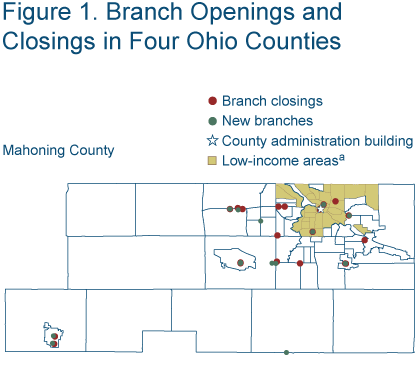
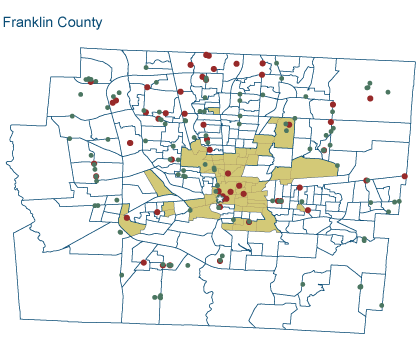
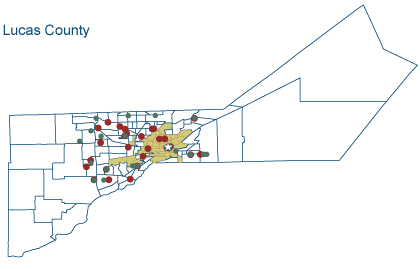
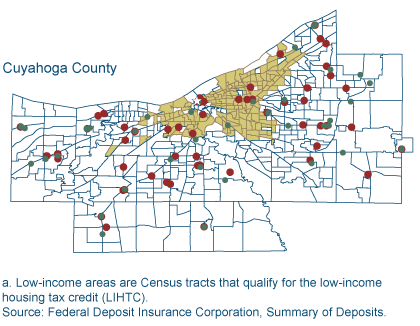
- Mahoning
- Franklin
- Lucas
- Cuyahoga
a. Low income areas are Census tracts that qualify for the low-income housing tax credit (LIHTC)
Source: Federal Deposit Insurance Corporation, Summary of Deposits
To get a more accurate view, we plot the number of branches at various distances from the county administrative building, which we assume to be the city center (figure 2). In Franklin County the number of net new branches increased at almost all distances from the county seat from 2001 to 2010. In Cuyahoga, Mahoning, and Lucas Counties, however, banks tended to close their branches in city centers.
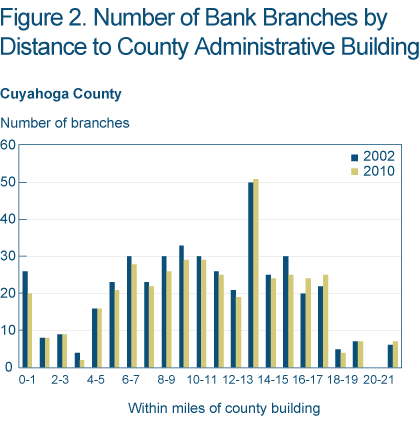
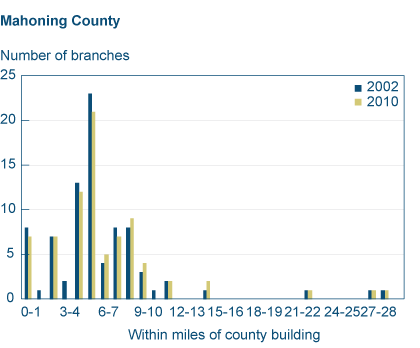
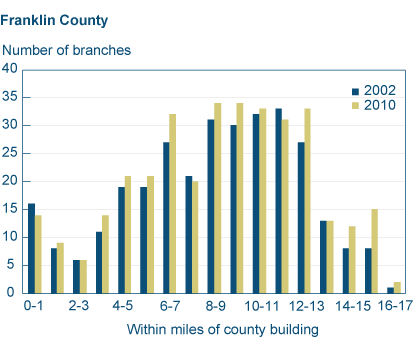
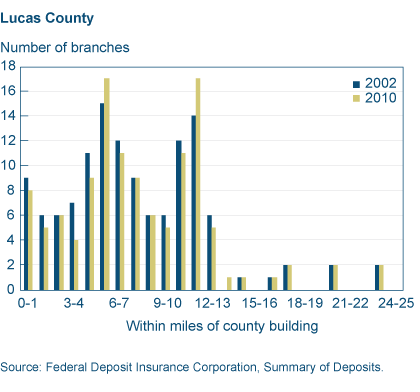
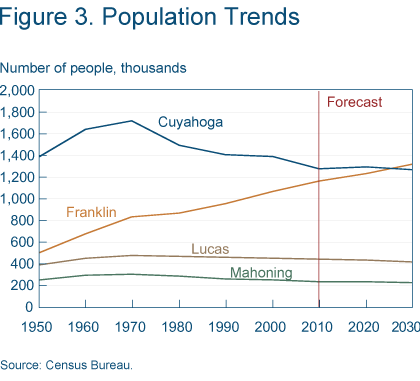
The population trends in figure 3 and other county characteristics in table 1 provide a glimpse into why banks may have behaved this way. Unlike Franklin County, Cuyahoga, Mahoning, and Lucas Counties have been losing population for many decades. A greater percentage of the population lives in poverty in those three counties, wages are growing more slowly, business establishments are closing, unemployment is higher, citizens are less educated, and the housing stock is much older. All in all, these characteristics suggest that Cuyahoga, Mahoning, and Lucas Counties may no longer be able to provide to banks the business opportunities that they used to, which could explain the closing of bank branches.
| Franklin | Cuyahoga | Mahoning | Lucas | |
|---|---|---|---|---|
| Percent below poverty level | 15.80 | 16.40 | 16.80 | 17.30 |
| Percent change in private sector business establishments (2003–2009) | 0.90 | -2.60 | −1.70 | −2.10 |
| Percent change in average employment (2003–2009) | −1.20 | −4.30 | −3.50 | −5.60 |
| Percent change in average weekly wage (2003–2009) | 17.50 | 17.20 | 12.70 | 10.30 |
| Unemployment rate | 7.3 | 7.9 | 9.4 | 9.3 |
| Percent with high school degree or less | 38.50 | 45.30 | 54.50 | 47.80 |
| Median year house built | 1972 | 1953 | 1958 | 1957 |
| Vacant housing units (percent) | 11.90 | 12.70 | 11.90 | 11.60 |
Sources: Bureau of Labor Statistics; Census Bureau.
But what are the implications for people who live in areas that lost a bank branch? How are they affected by access to fewer and more distant branches? These are the questions we turn to next.
Why Do Bank Branches Matter?
Economists have long theorized that a bank with a brick-and-mortar presence can develop valuable know-how about the credit risk and business opportunities in its market by interacting with consumers and businesses as it delivers loan and deposit products. The idea is that a physical presence is key because the bank has to interact repeatedly with the community to develop the necessary relationships.
For example, imagine a simple world in which there are only two mortgage applicants, both with credit troubles in their past. The first applicant now prioritizes her expenses so that she can pay her mortgage first, the other applicant has trouble setting her priorities in a responsible manner; she enjoys splurging once in a while, even if that means she might miss a mortgage payment or two or perhaps even default. Neither applicant can provide a down payment, and the lender cannot determine which applicant is the creditworthy one by looking at the tainted credit scores or the limited financial information they can provide. If it could, then the responsible applicant would get a lower-interest loan reflecting her lower risk, and the other would get a higher-cost loan or be denied.
But here is the problem. If the lender charges a low interest rate on mortgages to make them affordable to the creditworthy applicant, it will lose money because the other applicant will also get the same mortgage and potentially default. If the interest rate is high enough so that the lender is compensated for the likely credit loss, then the loan becomes unaffordable to the creditworthy applicant and only the applicant who does not mind missing payments shows up at the branch. Thus the lender finds itself in a bind; no matter what the interest rate is, it is never profitable to lend in this market; as a result, creditworthy borrowers cannot get credit. Economists refer to this problem as adverse selection.
Bank-customer relationships can overcome this obstacle. For banks, interactions with customers allow them to gather information on a customer, so-called soft information, which is not easily captured in a credit score. For example, if the prospective loan customer has a checking account with the bank, then the bank can glean information from that account on how well the loan applicant manages her money. Things like an average account balance, propensity to overdraw the account, and the regularity of deposits signal information to the bank about the customer. This is the kind of information that only the bank with the checking account relationship could easily collect. Indeed, a recent study has found that banks that have access to this sort of usage information from their loan customers’ other accounts are able to identify the more creditworthy borrowers.
Banks operating in a local market are also more likely to have information on the local economy, giving them a context from which they can evaluate the future prospects of a borrower that is not readily available to an out-of-market lender. For instance, a bank with close ties to your market may know that your employer is having financial difficulties and that it was turned down for a loan. This would make you, its employee, a high-risk borrower. Alternatively, you may be a temporary worker, but your banker may have heard from your employer during a game of golf that the business is expanding and will need new employees. This means that your temporary position may become permanent. You are in fact a lower-risk borrower than it may seem to a distant lender, who evaluates you based on the job title written on your paystub.
Because the gathering of soft information is difficult to do without a physical presence in a local market, the closing of a bank branch is different from the closing of a grocery store. One can still buy oranges, perhaps at a higher cost, by traveling farther to a different grocery store. But one cannot always get a loan by traveling to a distant lender.
This may sound like the George Bailey-style relationship-based lending that you may have seen in the movie It’s a Wonderful Life, rather than the modern banking of the 21st century. There is some truth to that belief. Over the last 30 years, banking has moved away from the intimate relationships described above to a more arm’s-length business model based on complex risk estimations (credit scores) and other automated underwriting (origination) rules. Those new tools have freed banks to lend wherever they want without relying on branch presence. Credit bureaus can supply lenders with information about your past borrowing and repayment habits, which are a good indicator of your future behavior. They may not be as good of an indicator as really getting to know the borrower, but obtaining a credit score is so much cheaper than maintaining a branch that the cost savings are worth the higher risk.
Both lenders and borrowers have benefited in some ways from this shift in business practices. A mortgage that took 90 days to close in the old days now takes less than a month for most borrowers. Lenders can originate loans at a higher volume without charging higher interest rates—an upward shift in the supply curve, as economists would call it—so more credit is available. Research does indeed show that the broader adoption of credit scoring among lenders has been associated with an increase in the overall supply of credit, along with an increasing distance between lenders and borrowers.
It was once thought that there was no role left for lenders like George Bailey in the mortgage markets. Lenders who use credit scores and other hard information like paystubs and bank statements were thought to have driven out the neighborhood banker who knew your father and his father before that. As it turns out, while credit scores are great tools to separate people with past credit problems from those with spotless balance sheets, they are not a perfect screening device when it comes to separating people who defaulted for good reasons, such as life events, from people who defaulted for bad reasons, such as the inability to control their spending habits. Recent research finds that a physical branch presence and intimate knowledge of a neighborhood and a borrower can help creditworthy borrowers in the pool of applicants with low-credit scores.
Who Benefits Most from Neighborhood Banking?
The beneficial-relationships argument has some interesting implications, which can be validated with data. First, the main beneficiaries among borrowers should be the ones that find it difficult to access credit from banks that use the lower-cost automated underwriting criteria. These are people typically with low incomes, tainted credit histories, and low credit scores. Therefore, they would benefit from any additional piece of information not captured by the score. Second, if relationship lenders are better informed about borrowers’ creditworthiness, we should observe fewer instances of default among the loans they make. Third, with the uncertainties about borrower quality eased and default risk reduced, credit should become more abundant and cheaper if there are bank branches in low-income area. Our research revealed evidence that supports all three implications.
On the default issue, we find that low-income homebuyers who obtain their mortgages from banks with branches in their neighborhoods are less likely to default than homebuyers who use banks without a branch in the area or mortgage brokers. This effect is especially strong among borrowers with low credit scores. While the average default rate for this group was around 20 percent, the default rate of those borrowers who took their loans from a local bank was up to 4.3 percentage points lower. Also as predicted, the price of mortgage credit does indeed decline, and its availability increases as there are more bank branches closer to low-moderate income areas—an effect that is too strong to be explained by increased competition alone. There is no similar effect in higher-income areas.
These findings suggest that a physical presence gives banks the opportunity to get to know distressed areas better and channel resources to people who can manage them best. However, these creditworthy people are also likely to be financially constrained, and so unlikely to be able to bear the full cost of keeping a branch open in an area with declining business opportunities. Thus, they are the ones who will be worse off when branches close. Our research shows the benefits that come from creditworthy borrowers in declining low-income areas being in close physical proximity to a bank branch. The public policy challenge is to identify how to get those benefits when private markets alone do not provide them.
References
- “Bank Branch Presence and Access to Credit in Low-to-Moderate-Income Neighborhoods,” by O. Emre Ergungor, 2010. Journal of Money, Credit and Banking, vol. 42.
- “Benefits of Relationship Banking: Evidence from Consumer Credit Markets,” by Sumit Agarwal, Souphala Chomsisengphet, Chunlin Liu, and Nicholas S. Souleles, 2010. Federal Reserve Bank of Chicago working paper no. 2010-05.
- “Beyond the Transaction: Depository Institutions and Reduced Mortgage Default for Low Income Homebuyers,” by O. Emre Ergungor and Stephanie Moulton, 2011. Federal Reserve Bank of Cleveland working paper no. 11-15.
- “Distance and Private Information in Lending,” by Sumit Agarwal and Robert Hauswald, 2010. Review of Financial Studies, vol. 23.
- “Commercial Lending Distance and Historically Underserved Areas,” by Robert DeYoung, W. Scott Frame, Dennis Glennon, Daniel P. McMillen, and Peter Nigro, 2007. Federal Reserve Bank of Atlanta working paper no. 2007-11a.
- “Credit Scoring and the Availability, Price, and Risk of Small Business Credit,” by Allen N. Berger, W. Scott Frame, and Nathan H. Miller, 2005. Journal of Money, Credit, and Banking, vol. 37.
Suggested Citation
Ergungor, O. Emre, and Stephanie Moulton. 2011. “Do Bank Branches Matter Anymore?” Federal Reserve Bank of Cleveland, Economic Commentary 2011-13. https://doi.org/10.26509/frbc-ec-201113
This work by Federal Reserve Bank of Cleveland is licensed under Creative Commons Attribution-NonCommercial 4.0 International




